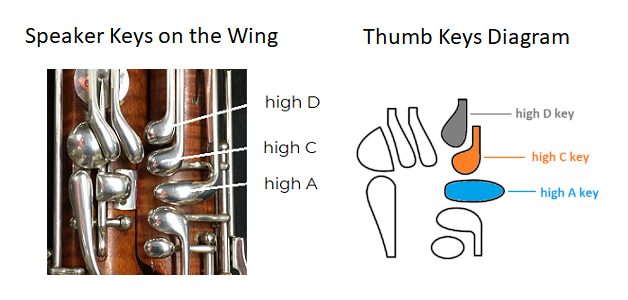Which notes use the Speaker Keys?

Why do we use the Speaker Keys?
- Improve clarity of response/articulation (eliminates “bark” or hesitation)
- Facilitates slurring to speaker key notes from above and below.
The notes at the top of the bass staff share fingerings with the notes at the bottom of the bass staff except that the whisper key is not pressed. While it is possible to get the notes to respond without the speaker keys by using fast air speed and optimal breath support, most beginning students tend to tighten the lips to get the upper notes. This creates inconsistent response, poor tone quality, sharp intonation, fatigue, a very small dynamic range, and leads to using the lips too much and not using enough air.
The “Speaker Keys” are so named because they allow notes to speak/respond easily, without additional lip pressure. The speaker keys allow the player to:
- Maintain a full tone in the middle and upper octaves,
- Improve intonation and flexibility,
- Center the tone in upper octave,
- Reduce muscle fatigue.
Where are the Speaker Keys?
The speaker keys are located on the wing joint.

Which finger operates the Speaker Keys?
The left thumb operates the speaker keys. This means your left thumb must release the whisper key and move up to the speaker keys.
How do I decide which speaker key to use?
- Pressing one of the speaker keys may alter the pitch/timbre of the note slightly so choose the speaker key that creates the least pitch/timbre disruption.
- Some basic models of bassoons will not include a high D key. If there is no high D key the player must rely on a very fast air stream, raised back of the tongue, and slight increase in lip pressure to produce this note in the proper octave.
When do we use the speaker keys?
Bassoonists’ Commandment No. 1 is “Thou Shall Not Crack.”
This means:
- Use the appropriate speaker key when you want to guarantee a clear entrance on middle A, upper Bb, B, C, and D.
- Use the appropriate speaker key when you have a slur to middle A, upper Bb, B, C, and D.
There are two scenarios where you might be able to get away with not using the speaker keys:
- If you have an absolutely perfect reed that will let you play the speaker-key notes clearly and easily with no additional lip pressure, or
- If the notes are moving in stepwise motion between speaker-key notes.
Learning to use the speaker keys takes practice but it is an excellent habit to develop because it will make the response of the speaker key notes extremely reliable.
Tip:
For the best intonation and tone, maintain fast air speed and optimal breath support even when using the speaker keys.

Feedback/Errata